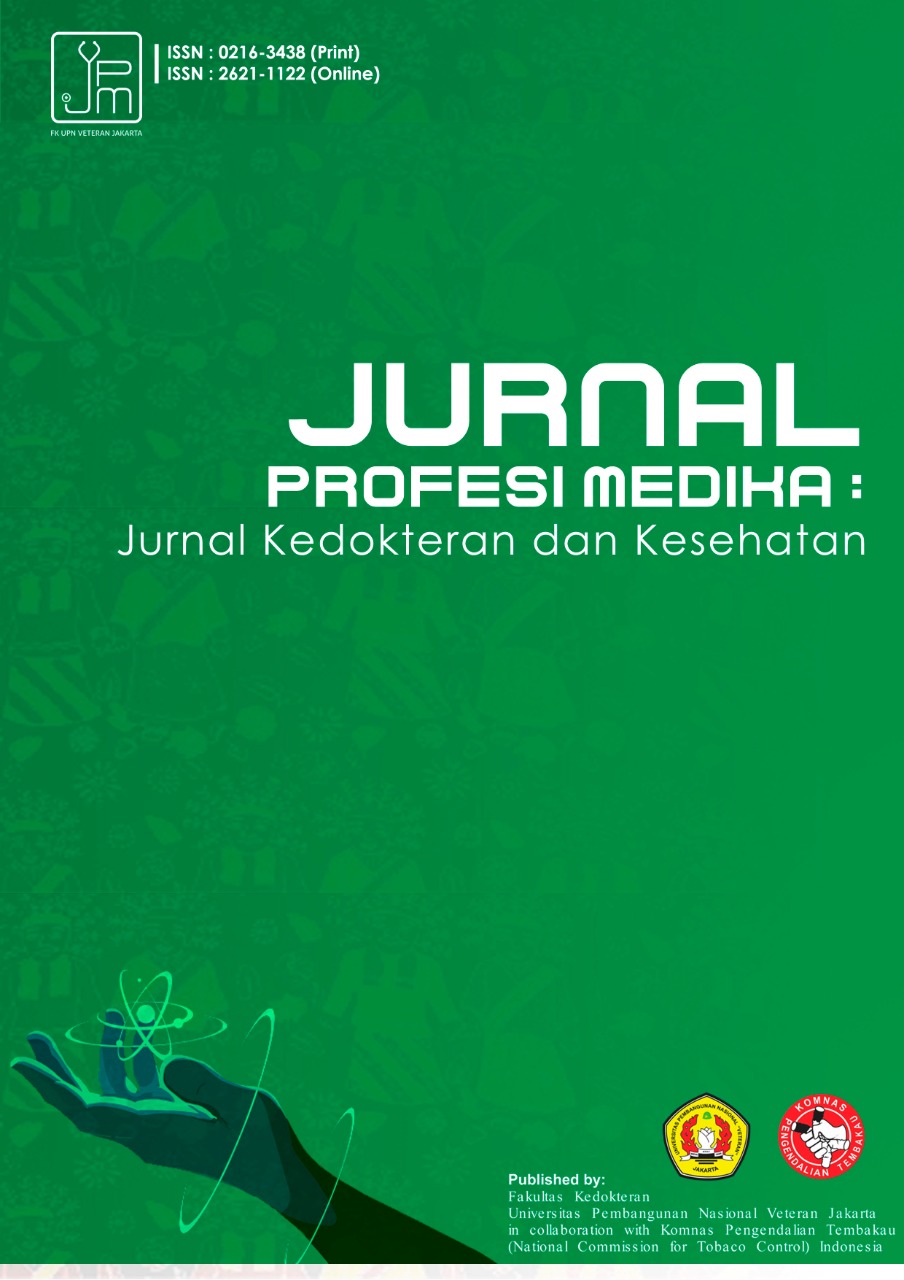Retroperitoneal Abcess Profiles in a Tertiary Hospital in Bandung, Indonesia : Long Term Retrospective Study
DOI:
https://doi.org/10.33533/jpm.v16i1.3414Keywords:
Characteristics, Retroperitoneal, AbscessAbstract
Retroperitoneal abscess is a rare and difficult-to-diagnose condition. The delay in diagnosis is the primary cause of mortality. We did a case series investigation to describe the profiles of retroperitoneal abscesses. We obtained retrospective data from medical records. We reviewed thirty patients admitted to our hospital with retroperitoneal abscesses from January 2013 to December 2019. Of 30 patients reviewed, 56.67% were male, with 50.14 years-old mean age. Approximately 46.67% presented with a chief complaint of back pain, and about 63.33% of cases had a fever. The most prevalent source was genitourinary, which accounted for 60% of the cases. The most common type of abscess was the perirenal abscess. Diabetes mellitus, malignancy, and an immunocompromised condition were all prevalent comorbidities. Escherichia coli was the most prevalent pathogen (46.66%), followed by Klebsiella pneumoniae (26.67%). For genitourinary abscesses, percutaneous drainage was typically used, whereas surgical drainage was recommended for gastrointestinal abscesses. The mortality rate of those conditions was 13.33%. Retroperitoneal abscesses have a wide range of clinical manifestations and causes. The treatment for retroperitoneal abscesses differed depending on the etiology and severity of the infection.
References
Huang SH, Lo WO, Lin CM, Hsieh TS, Wang SF, Tsai SW, Chen KC. Retroperitoneal abscess: 7-year experience of 29 cases in a tertiary care center in Taiwan. Urological Science. 2015;26(3):218-21.
Alfarissi F, Putri NM, Atmoko W. Multidisciplinary approach for large retroperitoneal abscess management: A case report. International Journal of Surgery Case Reports. 2021;80:105668.
Ruscelli P, Renzi C, Polistena A, Sanguinetti A, Avenia N, Popivanov G, Cirocchi R, Lancia M, Gioia S, Tabola R. Clinical signs of retroperitoneal abscess from colonic perforation: Two case reports and literature review. Medicine. 2018;97(45).
Aslan R, Özgökçe M, Eryılmaz R, Duran MA, Yıldızhan M, Taken K. Retroperitoneal abscesses: Origin, ethiology and percutaneous treatment. East J Med. 2018;23(4):269–274.
Rivera CJ-P. Retroperitoneoscopic drainage of a retroperitoneal abscess when open surgery is not an option: a novel surgical technique. MOJ Clin Med Case Reports. 2019;9(3):60–62.
Lin CH, Chou SJ, Wu HS, Yu JC, Chuang CH, Shih ML. Gastrointestinal: retroperitoneal abscess caused by appendicitis. Journal of gastroenterology and hepatology. 2007 Feb;22(2):278-.
Ishan UG, Thilakasiri MC, Weeratunga PN, Lanerolle RD. Successful medical management of a retroperitoneal abscess: a difficult diagnosis in pyrexia of unknown origin. Case Reports in Infectious Diseases. 2020; 27;2020.
Vida L, Mironescu A. Retroperitoneal Abscess Following Appendectomy: A Case Report. Bulletin of the Transilvania University of Brasov. Medical Sciences. Series VI. 2014;7(1):97.
Serviste A, Retroperitoneal D, Abse B, Raslanan N, Olgu B. Assessment of a Giant Retroperitoneal Abscess in Emergency Department: An Unusual Case Presentation. Harran Üniversitesi Tıp Fakültesi Derg. 2016;13(2):169–175.
Shenoy PA, Vishwanath S, Gawda A, Shetty S, Anegundi R, Varma M, Mukhopadhyay C, Chawla K. Anaerobic bacteria in clinical specimens–frequent, but a neglected lot: a five year experience at a tertiary care hospital. Journal of Clinical and Diagnostic Research: JCDR. 2017;11(7):DC44.
Asai N, Ohkuni Y, Yamazaki I, Kawamura Y, Kaneko N, Aoshima M. Clinical manifestations and prognostic factor of iliopsoas abscess. J Glob Infect Dis. 2013;5(3):98–103.
Ouanes Y, Sellami A, Chaker K, Bibi M, Rhouma SB, Nouira Y. Retroperitoneal necrotizing fasciitis with gas gangrene caused by urethral stricture. Urology Case Reports. 2018;20:7.
Downloads
Additional Files
Published
How to Cite
Issue
Section
License
Copyright Notice
All articles submitted by the author and published in the Jurnal Profesi Medika : Jurnal Kedokteran dan Kesehatan, are fully copyrighted by the publication of Jurnal Profesi Medika : Jurnal Kedokteran dan Kesehatan under the Creative Commons Attribution-NonCommercial 4.0 International License by technically filling out the copyright transfer agreement and sending it to the publisher
Note :
The author can include in separate contractual arrangements for the non-exclusive distribution of rich versions of journal publications (for example: posting them to an institutional repository or publishing them in a book), with the acknowledgment of their initial publication in this journal.
Authors are permitted and encouraged to post their work online (for example: in an institutional repository or on their website) before and during the submission process because it can lead to productive exchanges, as well as earlier and more powerful citations of published works. (See Open Access Effects).






